Factors associated with psychological distress during the coronavirus disease 2019 (COVID-19) pandemic on the predominantly general population: A systematic review and meta-analysis
- PMID: 33370404
- PMCID: PMC7769562
- DOI: 10.1371/journal.pone.0244630
Factors associated with psychological distress during the coronavirus disease 2019 (COVID-19) pandemic on the predominantly general population: A systematic review and meta-analysis
Abstract
Background: The Coronavirus Disease 2019 (COVID-19) outbreak has escalated the burden of psychological distress. We aimed to evaluate factors associated with psychological distress among the predominantly general population during the COVID-19 pandemic.
Methods: We searched PubMed, EMBASE, Scopus, Cochrane Library, PsycINFO, and World Health Organization COVID-19 databases (Dec 2019-15 July 2020). We included cross-sectional studies that reported factors associated with psychological distress during the COVID-19 pandemic. Primary outcomes were self-reported symptoms of anxiety and depression. Random-effects models were used to pool odds ratios (OR) and 95% confidence intervals (CI). The protocol was registered in PROSPERO (#CRD42020186735).
Findings: We included 68 studies comprising 288,830 participants from 19 countries. The prevalence of anxiety and depression was 33% (95% CI: 28%-39%) and 30% (26%-36%). Women versus men (OR: 1.48 [95% CI: 1.29-1.71; I2 = 90.8%]), younger versus older (< versus ≥35 years) adults (1.20 [1.13-1.26]; I2 = 91.7%), living in rural versus urban areas (1.13 [1.00-1.29]; I2 = 82.9%), lower versus higher socioeconomic status (e.g. lower versus higher income: 1.45 [1.24-1.69; I2 = 82.3%]) were associated with higher anxiety odds. These factors (except for residential area) were also associated with higher depression odds. Furthermore, higher COVID-19 infection risk (suspected/confirmed cases, living in hard-hit areas, having pre-existing physical or mental conditions) and longer media exposure were associated with higher odds of anxiety and depression.
Interpretation: One in three adults in the predominantly general population have COVID-19 related psychological distress. Concerted efforts are urgently needed for interventions in high-risk populations to reduce urban-rural, socioeconomic and gender disparities in COVID-19 related psychological distress.
Conflict of interest statement
The authors have declared that no competing interests exist.
Figures


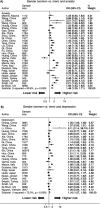
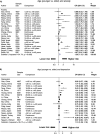
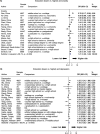
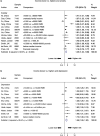
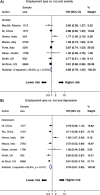
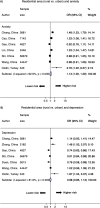
References
-
- World Health Organization [Internet]. Coronavirus disease (COVID-19) outbreak. 2020. [cited 2020 Aug 24]. Available from: https://www.who.int/emergencies/diseases/novel-coronavirus-2019.
Publication types
MeSH terms
LinkOut - more resources
Full Text Sources
Medical
Research Materials

